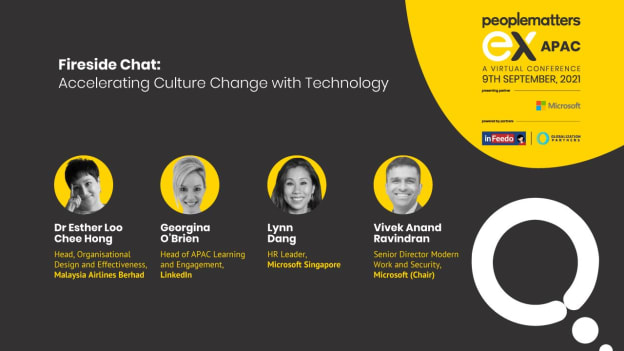Accelerating culture change with technology

With the world moving towards the hybrid way of working, HR also needs to relook at their approach towards the employee experience. Organizations need to leverage technology & analytics to build a people-powered workforce.
In an interesting fireside conversation at People Matters EX APAC 2021, Dr. Esther Loo Chee Hong, Head, Organisational Design and Effectiveness, Malaysia Airlines Berhad; Georgina O’Brien, Head of APAC Learning and Engagement, LinkedIn; Lynn Dang, HR Leader, Microsoft Singapore and Vivek Anand Ravindran, Senior Director Modern Work and Security, Microsoft, who moderated the discussion, shed light on elements of a great employee experience and how HR can select the right tech platform for their workforce experience.
Kickstarting the conversation, Lynn shared that moving to hybrid work requires a more nuanced, thoughtful, and deliberate discussion. No area has undergone more rapid transformation than the way we work. However one thing is sure. Flexible work is here to stay. But it also comes with own set of challenges such as exhaustion and rethinking employee experience.
Microsoft has been researching into what makes a great employee experience and found there are six crucial elements to it- wellbeing, connection, focus, empowerment, growth, and purpose. And these six elements will also be crucial for the hybrid work setup.
Shifts in employee experience
The hybrid work has sparked shifts in how organizations are approaching employee experience. In that direction, Georgina shared that LinkedIn is focusing on the growth aspect of employees, investing in employees to help them understand what skills they need for their next play.
Another area of focus is around diversity, inclusion, and belonging. LinkedIn is working a lot on creating moments of belonging for employees in a hybrid work experience. It is also focusing on learning and introducing more courses in that direction.
When it comes to building a sustainable culture, there are many human aspects to it, shared Dr. Esther. Aviation industry was one of the hardest hit by the pandemic. But these testing times were also a test for the culture of Malaysia Airlines. When the pandemic hit, the leadership made it a priority to protect the employees. So everyone took a collective pay cut so that many jobs can be saved. In addition, skilling also became a high priority to redeploy the workforce and help them find opportunities in other areas of the organization.
Employee engagement in challenging times
With lockdowns and work from home scenarios, it has become imperative for organizations to put employee engagement and well-being at the centre. In that direction, LinkedIn doubled down on the use of their employee engagement tool Glint to understand how their employees were feeling. So it created a global program for well-being for its employees with initiatives such as a week off to rest or half day Fridays. It also doubled down on the L&D efforts to invest in employees and engage with them.
Seconding the same, Dr. Esther said that caring for our employees is as important as reskilling them. The organization should help them to grow and address their fears. In this direction, Malaysia Airlines partnered with a wellness company to help employees get through these difficult times.
Adding to the same, Lyn shared that wellbeing was important before the pandemic as well. It was just that the pandemic helped organizations accelerate how they are approaching well-being. Technology and well-being programs have become an enabler to help organizations further solidify well-being as a part of their foundational culture. And it’s here where leaders need to model their behavior to drive this.
Areas where technology can be the biggest enabler for HR
Technology can become a true enabler to support HR in enabling culture change and redefining employee experience by being more data driven. This is why LinkedIn relies heavily on Glint to understand employee emotions and feelings through heat maps. Secondly, it employs technology heavily in e-learning to create a much more productive organization.
For Malaysia Airlines, technology has specially helped in keeping the organization connected, cascading information so that everyone remains aligned with organizational strategies and priorities. It has also helped them understand the employee feedback from the ground and implement suitable programs for the workforce. The company also focusses on leveraging non-technical employees to further adoption of tech.
In conclusion, Lyn shared that to further tech adoption, companies need to bring about a mindset shift in employees so that instead of seeing technology as a burden, it should be seen as an enabler that can help them be more effective and balance their work life.
Click here to find out more about Microsoft Viva, and how the EXP platform can help you build a people-powered workforce.

















